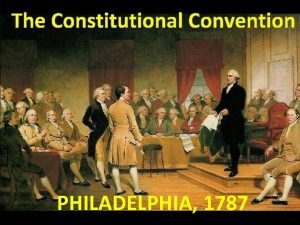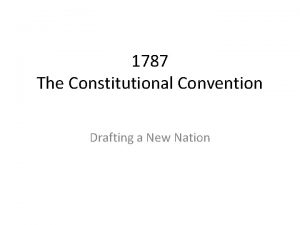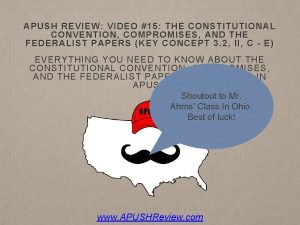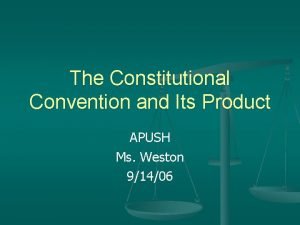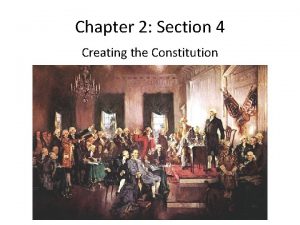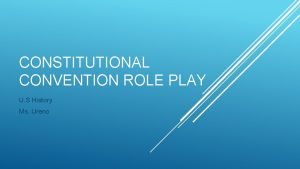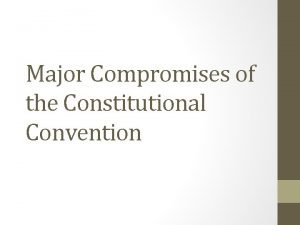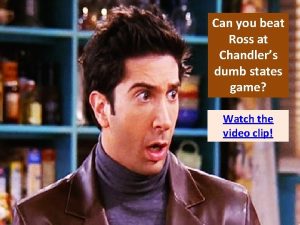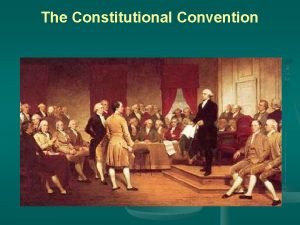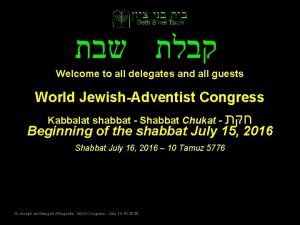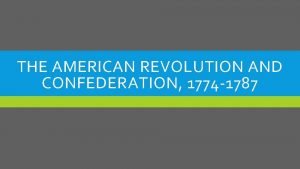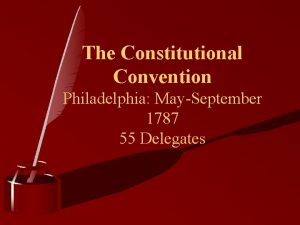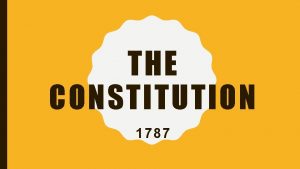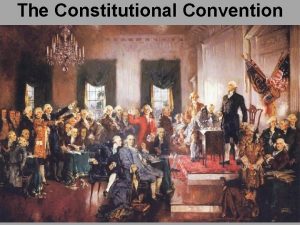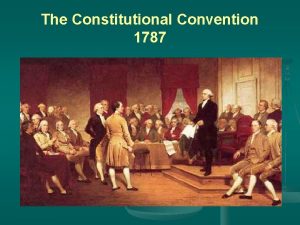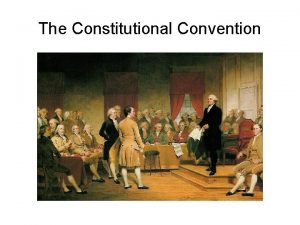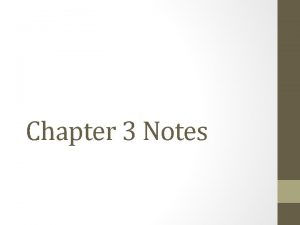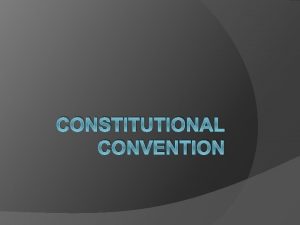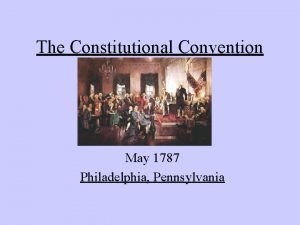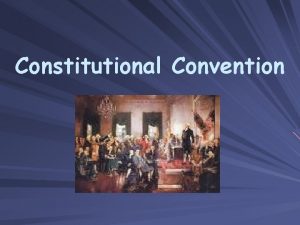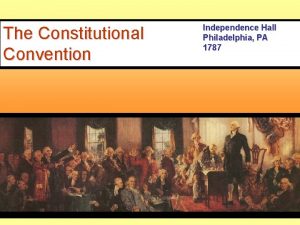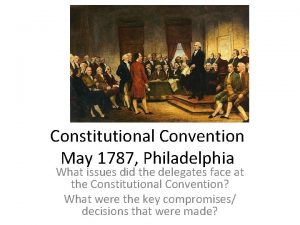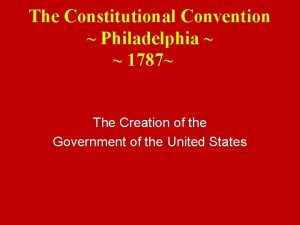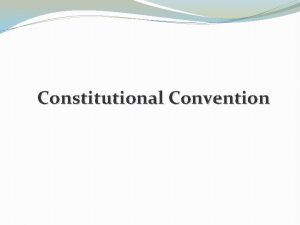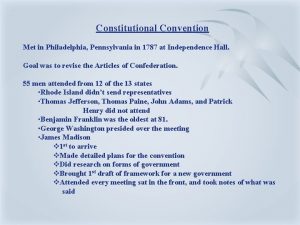CONSTITUTIONAL CONVENTION DETAILS 1787 Philadelphia Delegates from all



















- Slides: 19

CONSTITUTIONAL CONVENTION

DETAILS: • 1787 - Philadelphia • Delegates from all the states invited to a convention to improve the Articles of Confederation, which were not working • Only RI didn’t attend • 55 Delegates attended

WHO WAS THERE? • Wealthy upper class, white men • Selected by state legislatures, not popular vote • George Washington • Ben Franklin • Alexander Hamilton • James Madison considered the Father of the Constitution • Roger Sherman • Regardless, there was a ton of political talent at this convention

ABSENT • John Adams- ambassador to England • Thomas Jefferson- ambassador to France • Patrick Henry- “smelled a rat” • Sam Adams- not chosen by state to be part of the delegation

ISSUES THAT DIVIDED THE NATION’S LEADERS • The power of the federal government. Would the states or the federal government have the most power? • Representation in Congress (How many members on Congress would each state get? – small states wanted equal representation, large states wanted it to be determined by population of the states • Slavery – How would slaves be counted? Would the slave trade continue?

PRINCIPLES OF THE CONSTITUTION • Checks and Balances- A political system in which branches of government have some authority over the actions of the other branches • Limited Government- the idea that government is not all powerful, but can only do what the people allow it to.

PRINCIPLES OF THE CONSTITUTION • Federalism- the division of power between a central government and states • National level • State level • Local level

PRINCIPLES OF THE CONSTITUTION • Popular Sovereignty- the people rule. The power of the government is based on the consent of the governed. • Separation of powers- the division of the government into three separate branches: executive, legislative, and judicial.

COMPROMISES

VIRGINIA PLAN • Called for a new national government. Threw out the Articles of Confederation • Three separate branches of government. – executive branch, and judicial branch a legislative branch, • Representation in the legislative branch based on population of state • Large states like the plan, small states did not

NEW JERSEY PLAN • Legislature - has one house. • Each state gets one vote. • Small states like the plan, the large states hate it. • There would have to be a compromise

THE GREAT COMPROMISE • Legislature would have two houses (parts): House of Representatives and a Senate • House - based on the population of state • Senate - two senators per each state

THREE-FIFTHS CLAUSE • favors Southern states • All slaves would be counted in the census for representation in the House as 3/5 th of a person

ELECTORAL COLLEGE • People chosen by the state legislatures • Vote for president and vice-president • Supposed to reflect the will of the people

SLAVE AND TRADE COMPROMISE • Benefits both North and South • No taxes on exports • No interference with the slave trade for 20 years

AMENDMENT COMPROMISE • 2/3 vote of each house of Congress and ratified by ¾ of the state legislatures • 2/3 vote of both houses and ratified by state conventions of ¾ of the states (used 21 st amendment) • Proposed by a national constitutional convention requested by 2/3 state legislatures and ratified by ¾ state legislatures (never used) • Proposed by the national constitutional convention and ratified by ¾ of the specially formed state conventions

THE CONSTITUTION

BRANCHES OF GOVERNMENT • Executive – President and his cabinet • Legislative – Congress = House of Representatives and the Senate • Judicial – the Supreme Court and the Federal Court Systems

CLOSURE • Why did the delegates meet in Philadelphia in 1787? • Where was Thomas Jefferson? • What are the principles of the Constitution? • Explain the compromises made. • List the three branches of government. What role does each one have?
 Constitutional convention 1787
Constitutional convention 1787 Constitutional convention compromise
Constitutional convention compromise Constitutional convention
Constitutional convention Constitutional compromises
Constitutional compromises Constitutional convention article 5
Constitutional convention article 5 Constitutional convention compromise
Constitutional convention compromise Constitutional convention apush
Constitutional convention apush Creating the constitution answer key chapter 2 section 4
Creating the constitution answer key chapter 2 section 4 Lesson 1 - the constitutional convention
Lesson 1 - the constitutional convention Constitutional convention role play
Constitutional convention role play Compromises at the constitutional convention
Compromises at the constitutional convention Chandler's states game
Chandler's states game 3/5 compromise cartoon
3/5 compromise cartoon Constitutional convention begins
Constitutional convention begins Welcome all delegates
Welcome all delegates Welcome to all delegates
Welcome to all delegates Welcome all delegates
Welcome all delegates Welcome to all delegates
Welcome to all delegates Northwest ordinance of 1787
Northwest ordinance of 1787 Electoral college compromise 1787
Electoral college compromise 1787

